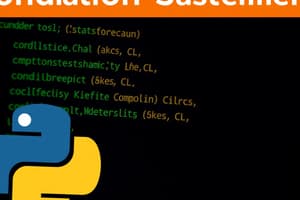Podcast
Questions and Answers
In Python, which statement is used to execute a block of code only if a specified condition is true?
In Python, which statement is used to execute a block of code only if a specified condition is true?
- `else`
- `if` (correct)
- `elif`
- `while`
In Python, indentation is purely for readability and does not affect the execution of conditional statements.
In Python, indentation is purely for readability and does not affect the execution of conditional statements.
False (B)
What is the primary purpose of the elif statement in Python?
What is the primary purpose of the elif statement in Python?
To specify a new condition if the first condition is false
The ______ statement in Python is used to execute a block of code when the condition in the if statement is false.
The ______ statement in Python is used to execute a block of code when the condition in the if statement is false.
Match each conditional statement with its correct description in Python:
Match each conditional statement with its correct description in Python:
Which of the following is the correct syntax for an if statement in Python?
Which of the following is the correct syntax for an if statement in Python?
In Python, logical conditions such as equals, not equals, less than, and greater than can only be used within if statements and not within loops.
In Python, logical conditions such as equals, not equals, less than, and greater than can only be used within if statements and not within loops.
In Python, what error will occur if the code inside an if statement is not properly indented?
In Python, what error will occur if the code inside an if statement is not properly indented?
In a nested if statement, the inner if statement is executed only if the condition of the ______ if statement is true.
In a nested if statement, the inner if statement is executed only if the condition of the ______ if statement is true.
Match each logical operator with its corresponding symbol in Python:
Match each logical operator with its corresponding symbol in Python:
What output will the following Python code produce?
a = 15
if a > 10:
print("Above 10")
if a > 20:
print("Above 20")
else:
print("Not above 20")
What output will the following Python code produce?
a = 15
if a > 10:
print("Above 10")
if a > 20:
print("Above 20")
else:
print("Not above 20")
In Python, you can only have one elif statement in a conditional block.
In Python, you can only have one elif statement in a conditional block.
In Python, what keyword is used to introduce the first conditional check in a series of conditional statements?
In Python, what keyword is used to introduce the first conditional check in a series of conditional statements?
In Python, the condition in an if statement must evaluate to a ______ value (True or False).
In Python, the condition in an if statement must evaluate to a ______ value (True or False).
Match the conditional operator with its definition:
Match the conditional operator with its definition:
What is the purpose of the following Python code?
if x > 5:
y = 10
else:
y = 5
What is the purpose of the following Python code?
if x > 5:
y = 10
else:
y = 5
In Python, the else block in an if-else statement is optional.
In Python, the else block in an if-else statement is optional.
In Python, how does the use of elif differ from using multiple separate if statements?
In Python, how does the use of elif differ from using multiple separate if statements?
The primary reason Python relies on ______ to define scope in conditional statements is to enhance code readability and avoid ambiguity.
The primary reason Python relies on ______ to define scope in conditional statements is to enhance code readability and avoid ambiguity.
Match the conditional statement with its corresponding usage.
Match the conditional statement with its corresponding usage.
What will be printed when the following Python code is executed?
x = 5
if x > 10:
print("Greater than 10")
elif x > 5:
print("Greater than 5")
else:
print("Not greater than 5")
What will be printed when the following Python code is executed?
x = 5
if x > 10:
print("Greater than 10")
elif x > 5:
print("Greater than 5")
else:
print("Not greater than 5")
In Python, an if statement can be used without an elif or else statement.
In Python, an if statement can be used without an elif or else statement.
Explain the significance of the colon (:) at the end of an if statement’s condition in Python.
Explain the significance of the colon (:) at the end of an if statement’s condition in Python.
A nested if statement is an if statement inside ______ if statement(s).
A nested if statement is an if statement inside ______ if statement(s).
Match the following descriptions of different Python conditional statement structures:
Match the following descriptions of different Python conditional statement structures:
What output will the following Python code produce?
age = 25
if age > 10:
print("Above 10")
if age > 20:
print("Above 20")
else:
print("Not above 20")
What output will the following Python code produce?
age = 25
if age > 10:
print("Above 10")
if age > 20:
print("Above 20")
else:
print("Not above 20")
In Python, the else statement can be used independently without an if statement.
In Python, the else statement can be used independently without an if statement.
In the context of Python conditional statements, what is a 'logical condition'?
In the context of Python conditional statements, what is a 'logical condition'?
In Python, when using a nested if statement, the level of ______ determines which if the else statement belongs to.
In Python, when using a nested if statement, the level of ______ determines which if the else statement belongs to.
Match the examples of Python conditional statements with their output based on x = 7 and y = 10.
Match the examples of Python conditional statements with their output based on x = 7 and y = 10.
Flashcards
Conditional Statements
Conditional Statements
Statements that execute different code based on conditions.
"if" statement
"if" statement
A conditional statement that executes a block of code if a condition is true.
"else" statement
"else" statement
A conditional statement that executes a block of code if the condition in the "if" statement is false.
"elif" statement
"elif" statement
Signup and view all the flashcards
Equals (==)
Equals (==)
Signup and view all the flashcards
Not Equals (!=)
Not Equals (!=)
Signup and view all the flashcards
Less than (a < b)
Less than (a < b)
Signup and view all the flashcards
Greater than (a > b)
Greater than (a > b)
Signup and view all the flashcards
Less than or equal to (<=)
Less than or equal to (<=)
Signup and view all the flashcards
Greater than or equal to (a >= b)
Greater than or equal to (a >= b)
Signup and view all the flashcards
Indentation in Python
Indentation in Python
Signup and view all the flashcards
Nested if Statement
Nested if Statement
Signup and view all the flashcards
Study Notes
Conditional Statements
- Conditional statements enable programs to perform different actions based on specified conditions
Types of Conditional Statements
ifspecifies executing a code block when a condition is trueelsespecifies executing a code block when the condition is falseelifspecifies a new condition to test when the initial condition is false
Python's Logical Conditions
- Equals:
a == b - Not Equals:
a != b - Less than:
a < b - Less than or equal to:
a <= b - Greater than:
a > b - Greater than or equal to:
a >= b
Example usage of if statement
- The following code tests if
bis greater thanaand prints "b is greater than a" if true
a = 33
b = 200
if b > a:
print("b is greater than a")
Indentation
- Python uses indentation to define the scope of code
- Other programming languages use curly brackets for this purpose
- Missing indentation in an
ifstatement raises an error
If Statement Syntax
if <EXPRESSION>:
# if block of statements
- The
ifstatement allows a block of Python code if a condition is true
Else Statement Syntax
if <EXPRESSION>:
# if block of statements
else:
# else block of statements
elsestatement is used to execute code if the initial condition is false
Nested If Statement Syntax
If <EXPRESSION>:
# if block of statements
If <EXPRESSION> :
# if block of statements
else:
# elif block of statements
- Nested
ifstatements involve placingifstatements inside otherifstatements
Example of a Nested If Statement
age = 13
if age> 10 :
print("Above 10")
if age> 20 :
print("and also above 20")
else :
print(" but not above 20")
Elif Statement Syntax
if <EXPRESSION>:
# if block of statements
elif <EXPRESSION>:
# elif block of statements
else:
# else block of statements
- The
elifstatement allows you to test multiple conditions in sequence
Elif Statement Example
time = 15
if time < 10 :
greeting = "Good morning"
elif time < 20 :
greeting = "Good day"
else :
greeting = "Good evening"
- In the example, different greetings are assigned based on the "time"
Types of If Statements
- if statement is the primary conditional statement
- else statement provides an alternative action when the if condition is false
- elif statement introduce additional conditions
Example of If Statements
x, y = 10, 20
if x == y :
print("x and y are equal.")
if x < y :
print("x is less than y.")
if x > y : # If there is only one line of statement to be executed,
# the curly brackets ({}) can be omitted
print("x is greater than y.")
Example of Else Statement
x = 200
if x < 100 :
print("It is less than 100.")
else :
print("It is greater than or equal to 100.")
Additional Example of Else Statement
a = 200
## If the remainder when a is divided by 2 is 0, it is even; otherwise, it is odd.
if a % 2 == 0 : # if division remainder is 0, a is even
print(“a is even.")
else : # if (a % 2 != 0) , if division remainder is not 0, a is add
print(“a is odd.”)
Example of Nested If Statements
x, y = 10, 20
if x == y :
print("x and y are equal.")
if x < y :
print("x is less than y.")
if (x > y) :
print("x is greater than y.")
}
x, y =10, 20
if x == y :
print("x and y are equal.")
else : # x != y
if x < y : print("x is less than y.")
else :
print("x is greater than y.")
Example of Elif Statements
x , y = 10, 20
if x == y :
print("x and y are equal.")
elif x < y : # (x != y) and (x < y)
print("x is less than y.")
else : # (x != y) and (x > y)
print("x is greater than y.")
Studying That Suits You
Use AI to generate personalized quizzes and flashcards to suit your learning preferences.




